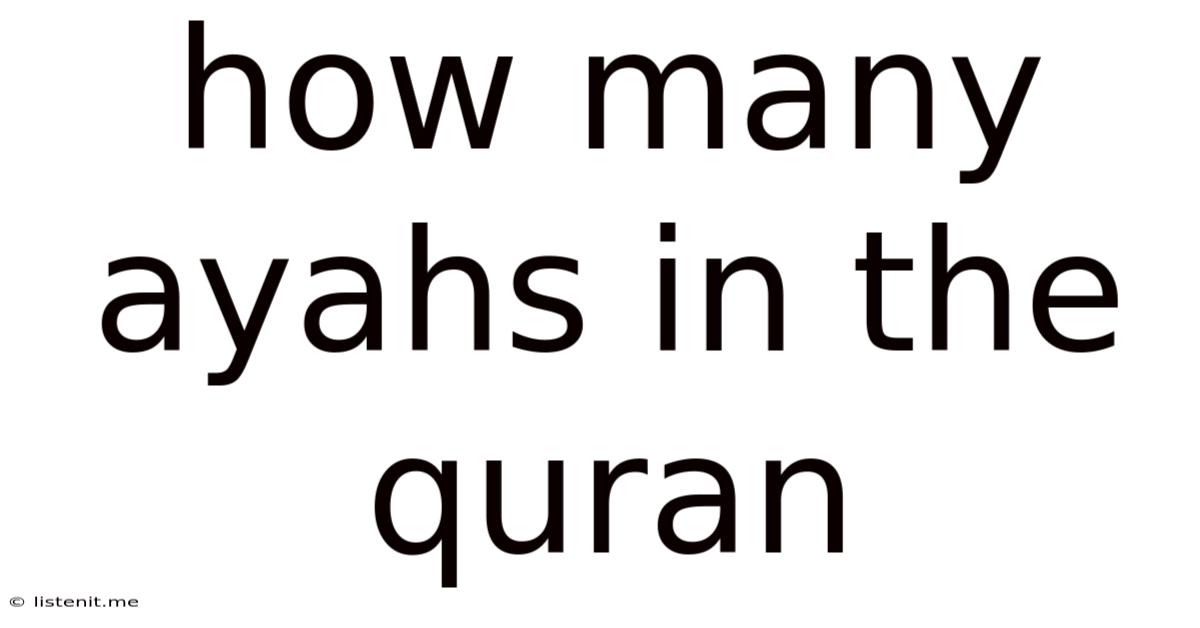How Many Ayahs In The Quran
listenit
Jun 14, 2025 · 4 min read

Table of Contents
How Many Ayah's are in the Quran? A Comprehensive Exploration
The Quran, the holy book of Islam, is a divinely revealed text considered by Muslims to be the literal word of God (Allah). Its structure, encompassing chapters (Surahs) and verses (Ayahs), is a subject of great reverence and scholarly study. One fundamental question often arises: how many ayahs are there in the Quran? While the answer seems straightforward, a deeper dive reveals nuances and variations depending on the method of counting. This article will delve into this question, exploring different perspectives and providing a comprehensive understanding of the Quran's structure and the complexities of verse counting.
The Simple Answer: 6,236 Ayah's
The most commonly accepted answer is that the Quran contains 6,236 ayahs. This figure is widely used and accepted by most Islamic scholars and organizations. It's the number found in the majority of printed and digital copies of the Quran. This number represents the verses as they are traditionally divided and recognized within the text.
However, the seemingly simple answer opens the door to a more intricate exploration. The exact number can fluctuate slightly depending on the methodology used for counting and the interpretation of certain textual elements.
Variations in Counting: Why the Discrepancy?
The slight variations in the total number of ayahs primarily stem from differing interpretations concerning:
1. The Counting of Basmalah:
The Basmalah, "Bismillah ar-Rahman ar-Rahim" (In the name of Allah, the Most Gracious, the Most Merciful), is a phrase that typically precedes each Surah, except for Surah At-Tawbah (Chapter 9). Whether to include this phrase as a separate ayah in each Surah, or to exclude it, leads to minor discrepancies in the total count. Many modern editions include it as the first ayah of each Surah except At-Tawbah, resulting in a higher total count than editions that exclude it entirely.
2. The Division of Long Ayah's:
Some exceptionally long ayahs might be divided differently in various manuscripts or editions. While the overall meaning remains the same, the division into smaller verses can lead to slight numerical differences. These divisions are often based on traditional interpretations and manuscript variations. This is more a matter of formatting than a true difference in content.
3. Variations in Manuscript Traditions:
Over the centuries, different manuscript traditions have emerged, carrying slight variations in the way the text is written or punctuated. These variations can affect verse divisions, though they are usually minor and do not alter the core meaning. The impact on the total ayah count is generally negligible.
Understanding the Structure of the Quran: Surahs and Ayah's
Before we continue analyzing the variations in the ayah count, it's crucial to understand the Quran's basic structure. The Quran is divided into 114 Surahs, or chapters, which are further subdivided into ayahs, or verses. The Surahs vary significantly in length, with some containing only a few ayahs, while others are comprised of hundreds. The order of the Surahs is generally believed to be of divine origin, although its precise rationale is a matter of ongoing scholarly debate.
The organization of the Quran is not merely arbitrary; the arrangement contributes to its overarching narrative and thematic unity. The progression of the Surahs often reflects a thematic arc, moving from shorter, earlier revealed verses (Meccan) to longer, later revealed verses (Medinan). This structural complexity further highlights the challenges and nuances involved in precise verse counting.
The Significance of Ayah's in Islamic Practice:
The ayahs of the Quran are not simply numbered verses; they hold profound spiritual and practical significance for Muslims. Each ayah is believed to contain deep wisdom, guidance, and divine messages. The recitation (tilawa) and memorization (hifzh) of the Quran, often ayah by ayah, are central practices within Islam. Furthermore, the ayahs are frequently cited and referenced in sermons, lectures, and daily life to guide actions and thoughts.
The importance given to the precise wording and arrangement of each ayah underlines the significance of understanding the subtleties involved in its study and interpretation. The quest for accuracy in understanding the Quran motivates the attention paid to even minor variations in the text and its numbering.
Conclusion: Beyond the Numbers
While the commonly accepted number of ayahs in the Quran is 6,236, it's essential to acknowledge the minor variations that can arise from different counting methods and manuscript traditions. These variations, however, do not negate the overall consensus or undermine the fundamental importance of the Quran's text. The focus should not solely be on the exact number but on the profound spiritual and intellectual richness embedded within each ayah. The meticulous study and deep understanding of these verses are far more important than quibbling over a few differing numerals. The Quran's message of faith, guidance, and justice remains consistent across all variations in counting. The slight discrepancies serve only to highlight the depth and complexities of this divinely revealed text and its enduring impact on billions of lives worldwide. The journey of understanding the Quran is a lifelong commitment that transcends the simple pursuit of a precise numerical answer.
Latest Posts
Latest Posts
-
Should You Shut Off Water While On Vacation
Jun 15, 2025
-
How To Make A Sticker Sticky Again
Jun 15, 2025
-
How Long To Let Caulk Dry Before Showering
Jun 15, 2025
-
How To Wire Two Lights One Switch
Jun 15, 2025
-
Why Is The Night Sky Orange
Jun 15, 2025
Related Post
Thank you for visiting our website which covers about How Many Ayahs In The Quran . We hope the information provided has been useful to you. Feel free to contact us if you have any questions or need further assistance. See you next time and don't miss to bookmark.